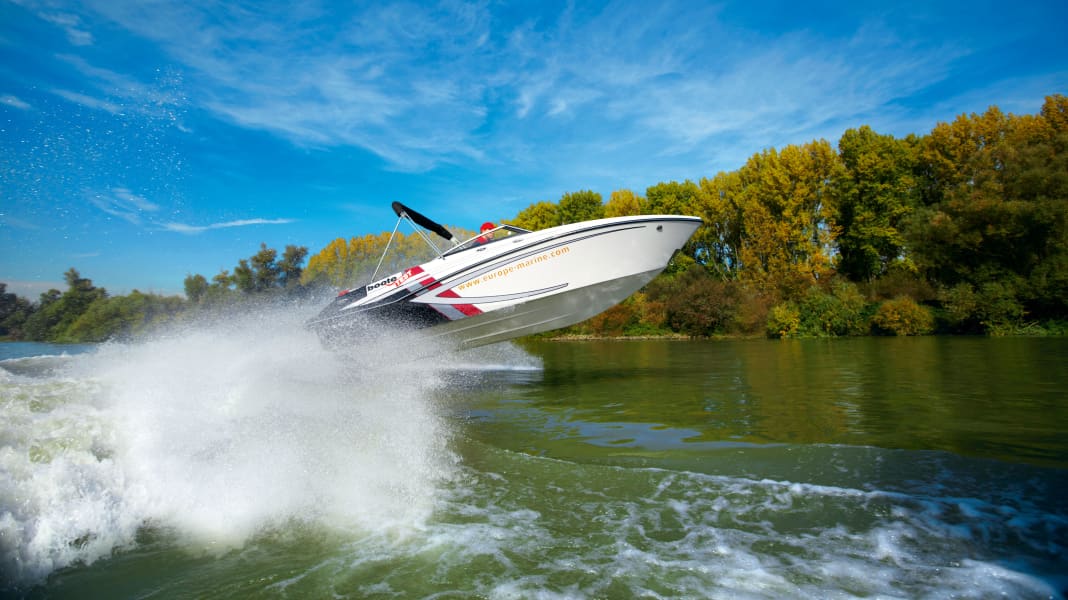







Our test boat belongs to the bowrider category. Fun on the water is at the top of the list of activities
on the list of activities. Crews of seven people are authorised, meaning that families and friends have plenty of space on board the glider. There is a tower for wakeboarders on the surcharge list, and a water ski towing eyelet is fitted as standard. The skis are stored under the cockpit floor in a long, narrow storage box. There are further storage options on board the GTS under the seat cushions in the bow and stern.
The main switch for the battery is also located under the latter. The 88 Ah energy storage system is mounted in the rear next to the engine using a strap. Access is via the engine cover, which is also a sunbed (2.00 m x 0.90 m) and can be opened using two gas pressure dampers. We searched in vain for a fire extinguishing system; only a "fire extinguishing port" is installed at the passageway from the bathing platform to the cockpit. The aft bench seat has a pull-out cushion on the port side, which allows the bench seat behind the co-driver's seat to be extended.
In contrast to most American sports boats, which are wider than the 2.55 m without a special licence from the 6 m class upwards, the GTS 205 is kept narrow at 2.44 m. The unladen weight also makes the Glastron attractive for road transport. The unladen weight of 1260 kg also makes the Glastron attractive for road transport. Attention: With this weight, however, you still have to add a lot of equipment and fuel. Trailer captains therefore look for a trailer with a minimum load capacity of 1400 kg. A trailer in the 1800 kg class is an option.
The selectable engine covers outputs between 200 hp and 300 hp. You can choose between a Volvo Penta or Mercury Mercury Cruiser petrol inboard engine. Powered
Our test boat is powered by a Mercury 5.0 MPI V8 small block. The manufacturer specifies an output of 194 kW (260 hp). The propeller is to be tuned to the full-load speed range between 4600 rpm and 5000 rpm; at the top speed of 84.3 km/h that we reached, the rev counter showed 5100 rpm. This means that the 3-x-14 1/4"-x-21" propeller is one size too small for our test load, consisting of 80 litres of fuel and two people.
The Glastron is easy to manoeuvre in the harbour. Turning circles forwards of 1 boat length over starboard and 1 1/4 boat lengths over port as well as astern on the spot emphasise this statement. Only reversing with the gear engaged in reverse takes a little longer, i.e. 6 s from starboard to port and 8 s back again. The transition from propulsion to planing begins at 2000 rpm by lifting the bow. The process is completed at 2800 rpm; during the entire time the foresight is only briefly obscured. If the skipper has forgotten to trim the drive to the transom when accelerating from a standstill, the transition takes longer and the view is obscured by the bow for a longer period of time.
The most economical speed was calculated to be 42 km/h or 3000 rpm. Combining speed with engine speed and tank capacity gives the range. The maximum range at canal speed (10 km/h) is 74 nm until the reserve of 15 % is utilised. If you are travelling at the economical 3000 rpm, 1.19 l/sm run through the fuel line. With the 121-litre fuel tank minus the reserve, this gives a range of 86 nm. A value that is below our 100 nm minimum requirement for boats in this class. Logically, the distance that can be travelled at top speed is significantly less. In the case of the Glaston GTS 205, it is 58 nm.
At the helm, the driver is informed of the boat's status (rpm, voltage, speed per dynamic pressure, engine temperature, oil pressure, depth and trim) by means of four round instruments. We are already familiar with the easy-to-read analogue displays from the Glastron GT 160, as well as the adjustable and easy-to-grip sports steering wheel. The hull rocks slightly, but harmlessly, along the longitudinal axis when travelling fast on slalom courses or when the steering wheel is twisted. The 180° turn cannot be performed at full steering lock, even with the drive trimmed to the transom, as the propeller begins to ventilate in this situation. You have to restart in order to regain traction. The situation is similar with increasingly tighter circles. Here the fuselage brakes slowly, without rocking and hooking, until the propeller catches air.
Conclusion:The Glastron GTS 205 lives up to the promise of its sporty outfit. It is safe to handle in terms of its handling characteristics. However, the boat is only poorly equipped as standard, so there is no getting round ticking the optional extras list.
Data sheet: 205 GTS
Shipyard: Glastron
Type designation: 205 GTS
CE category: C - Coastal waters
Material of hull and deck: Plastic
Length: 6,25 m
Width: 2,44 m
Displacement: 1,26 t
Price: 38.694,00 €

